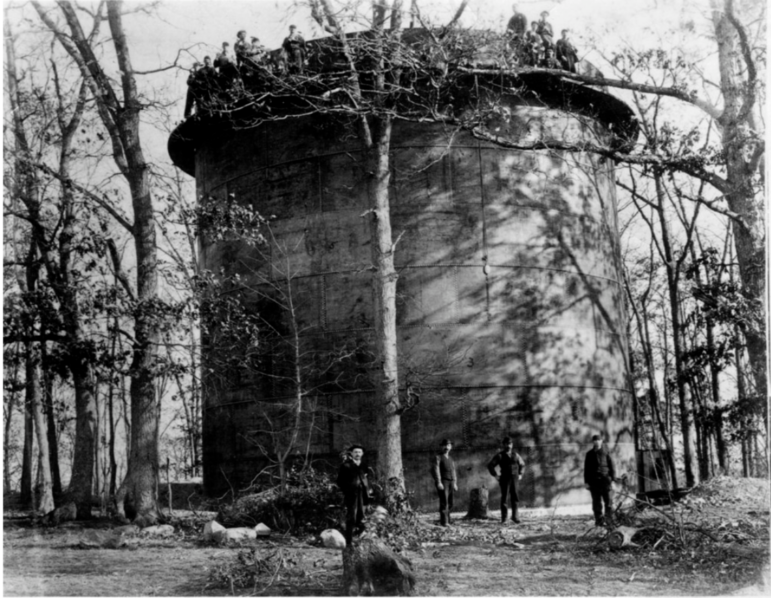
The following story is part of a series on local history provided by the Historical Society of Watertown. It was written by Sigrid Reddy Watson Terman for the October 2005 Historical Society newsletter, “The Town Crier.”
Sigrid is a former Board member and former President of the Historical Society, as well at a former Director of the Watertown Free Public Library. For several years starting in 1997, she wrote a Watertown history column for the Watertown TAB/Press called “Echoes.” Sigrid published her columns in a book called “Watertown Echoes: A Look Back at Life in a Massachusetts Town.” The book is available for purchase through the Historical Society of
Watertown for $10. To purchase it, please contact Joyce at joycekel@aol.com.
The Water Tower
Watertown is well known as the first permanent inland settlement in Massachusetts. It was actually first settled by a group under the pre-Puritan charter granted to the North Virginia Company, under the management of Sir Ferdinand Gorges, to be effective from 1600 to 1638. Under Gorges’ administration, in 1623, John Oldham was granted the right to establish a settlement situated seven miles up the “Massachusetts” river (later named the Charles) in what is now Watertown, in 1625. According to Captain John Smith, as early as 1614 there were 25 separate settlements in the area. Watertown, therefore, was already a sparsely-populated place along the river several years before the first Puritan village was founded in 1630.
In 1628, it is recorded that Thomas Cradoc, the financial head of the Massachusetts Bay Company, ordered that a mill be built above the point where the Indians had for centuries had an ancient ford. There the Indians, in their customary manner, established a temporary settlement; it was for the Indian trade in furs and fish that John Oldham had sought to obtain a charter from the Massachusetts Bay Company. At that time, long before the construction of the present Charles River Dam, the river was tidal, affording the opportunity for the construction of fish weirs, and it was not until later that the river was exploited for water power for the grinding of grain. Here also began the industrialization of Watertown, the building of the dam, and the introduction of the textile trade which eventually enriched New England.
The supply of drinking water for the population and their cattle was obtained from dug wells and by diverting water from water courses like the brooks that were once well known but have now become almost forgotten. (One of these was the Treadaway Brook, which ran from the top of Whitney Hill, under the present location of the public library, and joined the Charles River near present Watertown Square.)
By 1884 the town needed a reliable source of water free of seasonal fluctuations “to furnish the inhabitants of Watertown with water for the extinguishment of fire and for domestic and other
purposes …” Arthur Whiting and Franklin Fuller, surviving trustees of the estate of Nathaniel
Whiting, agreed to sell to the Watertown Supply Company a 100-foot square parcel of land near the top of Whitney Hill. If one climbs to the top of the hill, one can see there the remains of the old water tower.
According to old-time residents like Jack McCarthy, the tower’s situation was well known as a destination for local climbers. According to Jack, the site was behind 29-30 Everett Avenue, north of Palfrey Street and adjacent to his own backyard. The tower was constructed of brick, and
the remains of its foundation can still be seen there.
At one time there was a plan that the Town would build a Whitney Hill Park on the slope, but apparently, with the establishment of the Metropolitan Park Commission (now the Metropolitan
District Commission), [Editor’s note: and now the Dept. of Conservation and Recreation] the methods of water distribution had adequately been provided, and the tower had fallen into disuse. At the turn of the 20th Century the Park Commissioners reported that “by the courtesy of the Board of Water Commissioners, the lot containing the Water Tower has been turned over to the custody of the Park Commission; this place contains many desirable trees and will afford quite an addition to the Park area. The Water Tower, while not used at present, will be retained for emergency use of the Water Board.” There is no record that this ever occurred.
Is Whitney Hill the same as Palfrey Street.
Yes, Palfrey is on Whitney Hill. The wooded area above Victory Field is known as Whitney Hill.
Adjacent to his own back yard, you say? I thought all of Whitney Hill Park was our backyard. The remaining footings of the water tower were in fact still there when I was a boy. But what I remember most about that area was the nice leveled area and the basketball hoop up on a tree that still stands there to this day. My Mother and Dad have both passed. But I still have a ton of great childhood memories of playing in our woods as we called the park back then. Some of those memories are still secrets.
I grew up on Standish Road. We called what I understand now to be Whitney Hill, Palfrey Hill. In the winter, there was a wonderful toboggan chute from the top of the hill to Victory Field. For some reason, I always think of us tobogganing down that chute at night.